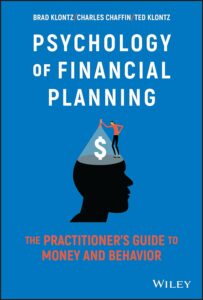Written By: Meghan McInnes, AFC®, FFC®, FBS®

Fall 2023 was my first semester teaching a college course, and I was very intentional with every course design decision I made, including the book selection. My goal was to find an accessible, easily readable, cost-friendly book with excellent content. After reviewing several options, I determined the “Psychology of Financial Planning: The Practitioner’s Guide to Money and Behavior” by Brad Klontz, Psy.D, CFP®, Charles Chaffin, Ed.D., and Ted Klontz, Ph.D. would best fit my course design vision. It met everything I was looking for, and my students were very pleased with it for the same reasons I chose it.
I described the course as practical with an emphasis on communication skills to motivate client financial behavior change. The “Psychology of Financial Planning: The Practitioner’s Guide to Money and Behavior” helped guide the class, breaking down difficult concepts into digestible pieces and providing actionable tips to use when working with clients. The materials are divided into five parts made up of three to six chapters, and each chapter ends with key takeaways.
Part I: The Psychology of Money
“Part I: The Psychology of Money” is made up of three chapters:”Financial Instincts: Why We Are Bad with Money,” “Behavioral Finance: Understanding Cognitive Biases and Heuristics,” and “The Environment.” Looking at human instincts from an ancestral lens, we better understand the conflicting societal expectations we have today and ancient instinctual nature. Building on this information, we can have a deeper understanding of behavioral finance biases, such as confirmation bias and loss aversion, and what financial professionals can do to help clients overcome these biases. Lastly in Part I, we explore the environmental impact on client decisions, such as culture, community, generation, and socioeconomic status.
Part II: Understanding a Client’s Financial Psychology
“Financial Flashpoints: Exploring a Client’s Financial Background,” “Money Beliefs,” and “Financial Behaviors and Outcomes” come together to create “Part II: Understanding a Client’s Financial Psychology.” Financial flashpoints are emotionally powerful life events associated with money that impact money beliefs, attitudes, and relationships. Money Scripts are introduced to provide further insight on the impact of financial flashpoints experienced and the financial professional’s role when working with a client. Using this information to dive even deeper, problematic financial behaviors and money disorders are introduced along with the financial professional’s role and referrals to mental health professionals.
Part III: Principles of Counseling, Psychology, and Communication
“Part III: Principles of Counseling, Psychology, and Communication” includes the chapters on “Sources of Money Conflict,” The Principles of Effective Communication, “Solution-Focused Techniques in Financial Planning,” “Cognitive Behavioral Approaches in Financial Planning,” “Positive Psychology in Financial Planning,” and “Working with Couples and Families: A Systems Perspective.” This section explores both internal and external sources of financial conflict, including discussions on motivation, power imbalances in money management, financial abuse, and elder financial abuse. Imperative communication techniques for financial professionals and a flow of communication are provided to assist in building a successful, long-lasting relationship with clients. Specific techniques include Solution-Focused, Cognitive Behavioral, and Positive Psychology.
Part IV: Client and Planner Attitudes, Values, and Biases
“Part IV: Client and Planner Attitudes, Values, and Biases” encompasses “Multicultural Competence in Financial Planning: Understanding Your Client’s Cultural Identity,” “Financial Risk Tolerance,” “Client-Preferred Learning Styles: Getting and Keeping Your Client’s Attention,” and “Client Values and Goals.” Essential topics related to cultural awareness and competencies, understanding and using various learning styles, assessing risk, and goal congruence are reviewed.
Part V: Integrating Financial Psychology into Financial Planning
Lastly, “Getting the Client to Take Action: Motivational Interviewing in Financial Planning,” “Helping a Client in Crisis,” “Assessment in Financial Planning,” and “The Role of the Financial Planner: Ethical Considerations in the Psychology of Financial Planning” guide “Part V: Integrating Financial Psychology into Financial Planning.” To help move the reader from concepts to concrete actions, the authors provide a review of the stages of change paired with tools to overcome resistance. We gain insight into client crises, actionable steps financial professionals can take in a crisis, and mental health referral considerations. We learn about different types of assessments and accompanying biases along with tips to provide ethical financial services.
I recommend this short, easily digestible, informative book not only for college courses but for field professionals. Though the Psychology of Financial Planning: The Practitioner’s Guide to Money and Behavior” is an excellent resource on its own, I appreciate the companion workbook, “Psychology of Financial Planning: Practitioner’s Toolkit,” as an accompaniment due to inclusion of materials for immediate application and practice.
About the Author:
Meghan McInnes, AFC®, FFC®, FBS® is the Director of the Center for Excellence in Financial Counseling and Assistant Teaching Professor of Personal Finance at the University of Missouri—St. Louis in the College of Business Administration. She has been an active AFCPE® member since 2015.
 Want to get involved with AFCPE®?
Want to get involved with AFCPE®?
Here are a few places to start: Become a Member, Sign up for an Essentials Course, or Get AFC Certified today!
Want to be an AFC®, but don’t know where to start? Sign up for a free info session!